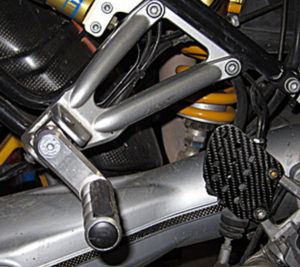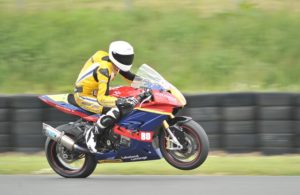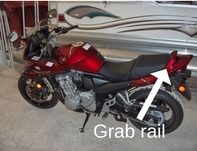In this guide we are going to be looking at the basic skills needed to carry a pillion passenger safely.
Firstly we’ll take a look at the law and what your current licence entitles you to do.
Then we’ll move on to what you should be doing as a driver to make riding with a pillion both safe and comfortable.
Finally we’ll have a look at what the passenger should be doing whilst riding pillion and how they should react to what you are doing as the driver.
Save Money On Your Motorcycle Insurance
- You could pay less than £195*
- Compare quotes from 25+ UK providers
- Fill in one form to compare top bike insurers
Riding Pillion, Licences and the Law
First things first – you must have a full motorbike licence before carrying a pillion passenger.
Completing Compulsory Basic Training (CBT) does not entitle you to carry a pillion.
If you do have the correct licence then the following rules also apply:
- The motorbike must be equipped with suitable supports or rests for the feet of the pillion passenger
- Pillion passengers must be capable of sitting astride a proper seat securely fixed to the motorcycle
- A pillion passenger must wear a suitably constructed safety helmet
- The decision to carry a passenger remains with the rider, who is legally responsible for ensuring that the passenger is safely supported
There are no specific age restrictions for the pillion passenger but anyone riding pillion must adhere to all of the above rules.
Source: Police National Legal Database
How to Carry a Pillion
Setting up the motorcycle
Before carrying a passenger you need to set up your motorbike to handle the extra weight. The following adjustments should be considered:
1. Adjust the pre-load on your rear shock absorber to compensate for the extra weight of carrying a pillion.
This should be a simple adjustment and usually involves tightening a cog on your shock.
Here’s a quick video with instructions.
2. Adjust tyre pressures – generally they will need more pressure, each motorbike is different so check the instructions in your bike manual.
3. Adjust mirrors: the extra weight on the back makes the rear run lower which can throw the mirrors out of line.
4. An obvious one but always flip out the pillion foot rests before setting off.

Communication
If you are a new or beginner rider it is likely that your pillion is also going to be inexperienced.
A quick chat abut the points below should put everyone at ease. (We’ll be covering these points in more detail in the riding pillion section below.)
- Mounting and dismounting
- Cornering
- Braking
- What to do when the bike stops at lights or junctions
- How to communicate
There are two ways rider and pillion can communicate whilst moving:
- The old way – agree a simple system of hand signals before setting off. For example two taps on the left shoulder means “please stop” etc
- The new way – purchase a Bluetooth communication system
Gear and Helmet
As a rider you should always be kitted out with a full set of safety gear and a helmet – your pillion deserves the same.
You’re unlikely to have a full set of spare leathers in the garage but make sure your passenger has a decent helmet, gloves, motorbike jeans and a protective jacket.
Riding style

You must adjust your riding style when carrying a pillion. Save the knee down cornering and hard acceleration for your solo ride.
Aim to make all your bike handling actions as smooth as possible, planning and anticipation will minimise the need for braking and gear changes.
The extra weight makes the bike handle differently and reduces it’s performance in general.
Your passenger doesn’t have a great view of the road ahead and wont be able to anticipate your actions.
Pay particular attention to the following:
1. Changing gears
If you’ve ever ridden with a pillion before you will be familiar with “helmet bump”. This is when the passengers helmet collides with your helmet usually during a gear change.
It happens because as you dip the clutch to change gears, the motorcycle’s speed drops slightly and your passengers natural “brace” reaction to acceleration causes them to dip forward and clash helmets.
The simple solution to this is to be extra smooth in your gear changes. It will also help if you can change gears quickly without losing much momentum.
It is better to practice this technique without a passenger until it becomes second nature.
2. Acceleration

Your motorcycle will accelerate more slowly with the extra weight so leave larger gaps in traffic when pulling out at junctions or overtaking.
Don’t be tempted to over compensate for this by accelerating too hard. This will be extremely unsettling for your pillion and the sudden shift of weight could make the bike unstable.
Again the watchword is smooth.
Nice smooth gentle acceleration whilst anticipating traffic conditions ahead will make for an enjoyable ride for your companion.
3. Braking
Your passengers weight will reduce braking efficiency so plan for longer stopping distances.
Brake early and try to use the engine brake when possible.
A pillions weight over the rear wheel will make your rear brake more effective so plan to use it a little more than you would when solo.
4. Steering
Steering will be heavier and more sluggish.
Scan further up the road ahead and try to avoid sudden changes of direction.
Slow speed manoeuvres such as filtering will become more difficult, be prepared to allow more space than usual when moving at slow speeds.
Have a look at this video, it covers the basics nicely.
How To Be a Good Pillion

If you are going to be sitting on the back choose your companion wisely.
Only ride with someone you completely trust and make sure to have a discussion about hand signals before you set off. Knowing you can signal the driver to stop will boost your confidence and allow you to relax into the ride.
Always wear good quality safety gear and a helmet, any decent rider will insist on this.
If your driver is kitted out in full leathers whilst happy to leave you in trainers and shorts ask yourself why.
Getting on the motorcycle
Many a biker has ended up in an embarrassing heap on the floor as an over eager pillion has clambered on without asking.
Let the rider get on first and steady himself in position with both feet squarely on the ground.
When he gets comfortable and set in a stable position he will give you the nod.
Get on from the left hand side, swing your right leg over the bike and on to the peg, then bring your left leg up and shuffle into position with both feet on the pegs.
Avoid the temptation to mount the bike like you would a horse, putting all your weight on the left peg and using it to pull you up. This will make it difficult for the rider to keep the bike upright.
What do I hold?

There are a couple of options here, all are effective so choose the one which is most comfortable for you.
1. Grab rail
Hands behind the back with firm grip on grab rail.
2. Hold on to Rider
Put your hands around the waist of the driver. Try to adopt a relaxed but firm grip and move with the bike naturally.
Some pillions use a combination of methods with one hand on the grab rail and one around the drivers waist.
Again just do what feels right and alternate between the two on longer rides if necessary.
Cornering

If you are a new pillion rider the experience of cornering on a motorcycle can be unnerving.
It is natural for the motorbike to lean into corners so just follow the natural lean of the driver and bike.
Don’t try to fight the lean nor lean too far – flow fluidly with the bike and try to stay relaxed.
Do not change position suddenly or make any sharp movements whilst cornering.
Braking and Accelerating
You will naturally move forward towards the driver whilst braking, this can result in the classic helmet head butt.
To stop this happening anticipate the approach to junctions and roundabouts and brace yourself using the grab rail or if holding on to the rider, place one hand on the fuel tank to keep you in place.
Whilst accelerating the opposite force will occur and you will be pushed backwards. Again anticipation is key, grip the grab rail or rider firmly and lean forward slightly.
Slow speed manouevres
The extra weight added by a pillion passenger makes the motorbike harder to control at slow speeds as it affects the bikes balance.
The best thing you can do to help is to sit still and stay relaxed.
No fidgeting!
Stopping at Junctions
Do not put your feet down when the rider stops at junctions, lights or roundabouts.
The driver will balance the bike and remain in control until you are signaled otherwise.
Dismounting
Ask before getting off the motorcycle or agree a signal beforehand.
This prevents the bike falling over due to the sudden weight change – good for avoiding embarrassment.
Conclusion
Riding two up can be a fantastic experience for both driver and passenger.
As a rider you have a great responsibility for the safety of your pillion passenger, but don’t be put off.
Get geared up, ride smoothly and work together as a team and you will soon find that riding pillion comes as naturally as riding solo.
As always stay safe and have fun.
Image credit
Peter Shanks. CC creative commons, Attribution 2 generic.
